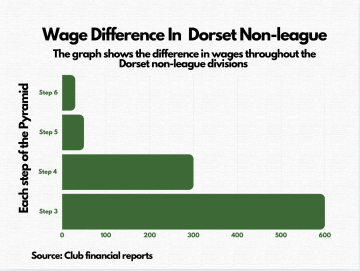New data comparing the football leagues shows us how much the earnings fall across the divisions.
The figure creates a challenge
for non-league clubs, as they must balance sustainable spending for the level the club is playing at with ambition for the club to succeed on the pitch.
At the higher tiers in Step 3 we have the Southern Premier League South.
Players in this division repor
tedly earn around £350–600 per week, with some new senior signings earning up to £700.
One local club in this division, Wimborne Town, has an estimated annual wage bill of around £250,000–£300,000, which shows the club’s ambition from investment in hopes to reach the National League South.
In Step 4, we see already a dramatic decrease in player wages, with clubs such as Hamworthy United spending approximately £200–350 per week.
They have an annual spend of £150,000 a year, which is enough to keep the club competitive within the division.
Their budget is funded through local sponsorship, entry fee, and local fundraising from the fans.
At Step 5 the wages fall harder, with the Bournemouth Poppies spending £40–£80 per game on the players, some even playing for travel expenses paid only.
Bournemouth Poppies manager Phil Brown has stated he is a volunteer at the club, which goes to show how important the volunteering element in non-league is with clubs fighting for financial survival.
Further down in Step 6 the wage difference is slightly lower compared to the division above, with club Sherborne Town spending £20–40 on some of their players.
They have an annual spending of less than £25,000, with the money that they make mostly going towards the pitch maintenance and their facilities, the graph below visualizes each steps spend from the examples used.



 Bridport Women’s midfielder awarded FA grant to complete coaching course
Bridport Women’s midfielder awarded FA grant to complete coaching course